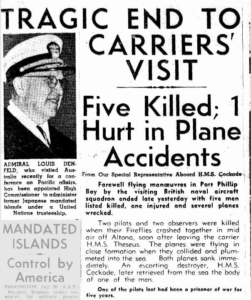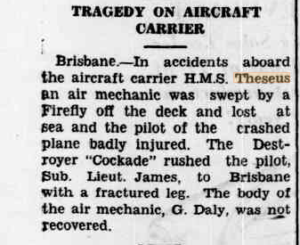April 2019
The following paper describes the experiences of a young Royal Navy conscript, Gordon Cansdale who served in the Fleet Air Arm from 1945 to 1947. Gordon describes the highs and tragic lows of service in the carrier HMS Theseus which visited Australia in 1947 to demonstrate naval air power and the capabilities of an aircraft carrier.
Gordon later settled in Australia where he has lived for more than 63 years.
The old saying that one only remembers the good times can be quite true, but in my case there was one bad time in particular that I will never forget.
As a teenager I learned a song that went something like this:
“Memories are treasures locked in my heart I mean to keep evermore. Of all the treasures one stands apart, saved from the dear days of ‘Yore’.“
Years ago, (1945) I received notice that I was to be conscripted into the armed forces. I was hoping that it would be the Navy as my father had served in the Navy in the 1914-18 war.
YES!! I was selected for the Royal Navy, better still, the Fleet Air Arm, a dream come true. Fighter aircraft, Rolls Royce engines, a chance to see the world, and of course a navy uniform.

So, my adventure began by first learning how to march, handle firearms, and not forgetting plenty of naval discipline. Next step was the Rolls Royce School of Technical Training. THIS WAS IT!! learning about the mighty Merlin engine.
On completing this course, I was posted to a shore establishment HMS Blackcap inhibiting engines for storage. This didn’t last long, as I soon learned that I had been given a sea-going draft. I was to become a member of 812 Squadron (Fireflies) and join HMS Theseus in Ireland.
After a short training period ashore in N. Ireland it was off to see the world. Those faraway places with strange sounding names. Gibraltar, Suez, Aden, Trincomalee, Andaman Islands, Nicobar Islands, Singapore, Australia, New Zealand, New Guinea.
The reception we received in Australia and New Zealand was just great. The street marches with the whole ship’s company through the streets of Melbourne, Sydney, Brisbane, Auckland and Wellington. The people were just fantastic, with dances and sight-seeing trips. They also organized home visits, and food parcels for our families back home.
BUT! it wasn’t all plain sailing, whilst flying and demonstrating for the Royal Australian Navy there were several disasters. Two Fireflies collided in midair over Port Phillip Bay and crashed into the sea killing both air crews. One of the engines was pulled up out of the sea some fifty years later, and is now in the Australian F.A.A. Museum in Nowra which I often visit with an old ‘oppo’ Totty Allman. The same day a Seafire crash landed on deck, the arrester hook striking a seaman in the walkway and killing him.
For me the worst was yet to come (my disaster day). It was the job of the ground crew to assist the pilot out of the cockpit on landing. I was the fitter of the Squadron CO’s aircraft (Lt Cdr Wynne-Roberts) and would compete with my rigger mate ‘Spiv’ Daly to be first up on to the plane to do the job. The winner would then have pole position sitting on top of the cockpit to watch the remainder of the aircraft land.
It was 6th August 1947 and Spiv had won the race, sitting on top of the cockpit, I had to settle for a seat on the wing. The next aircraft landed OK, the crash barriers were lowered and it taxied forward. THEN ALL HELL LET LOOSE. The third aircraft missed the arrestor wires and bounced over the crash barriers. To my horror I realised it was heading straight for us, so I dropped off the wing and ran for the ship’s side. It then clipped the second aircraft and dropped on top of ours. On impact, debris was showered everywhere, and as I was dropping into the safety net, the batteries burst and I was splattered with acid. Minutes later I was lifted out of the safety net and rushed below to sick bay, washed down, and treated for acid bums. My clothes had to be replaced as they were covered in holes, burnt by the acid.
I asked about Spiv and was told that he was missing, presumed killed. I couldn’t believe that I was with him just a short time before, and the last person to see him alive. Could easily have been me.
The things I will always remember are the noise of the plane bouncing, the terrific noise of the impact, and someone shouting “There’s somebody down in the net” ME!!! As they lifted me out there was a wheel, and Oleo leg nearby. All that remained of two aircraft.
When the deck was finally cleaned up, the last aircraft carne in to land, also bouncing over the crash barriers. It clipped the Island before crashing into the starboard gun sponson, then tipped over nose first into the sea. Luckily the aircrew were recovered safely.
From Australia, our next port of call was the Solomon Islands which was very interesting as there were ships and a submarine on the beach, Jap relics of the war a couple of years previous.
Port Moresby in New Guinea was also interesting, with a trip out to. Jackson airstrip which still had the odd Zero fighter, and a Betty bomber smashed up. Also, a wine bar.
Back to Singapore where I learnt I was to leave Theseus and return home for demob with others who had the same demob number as me (72).
The rest of my service was spent at HMS Nuthatch, doing maintenance, cutting grass, painting fences etc. Finally, my demob and the end of a great adventure with many good times, and a few bad. Plus, many great friends, and a lot of MEMORlES.








